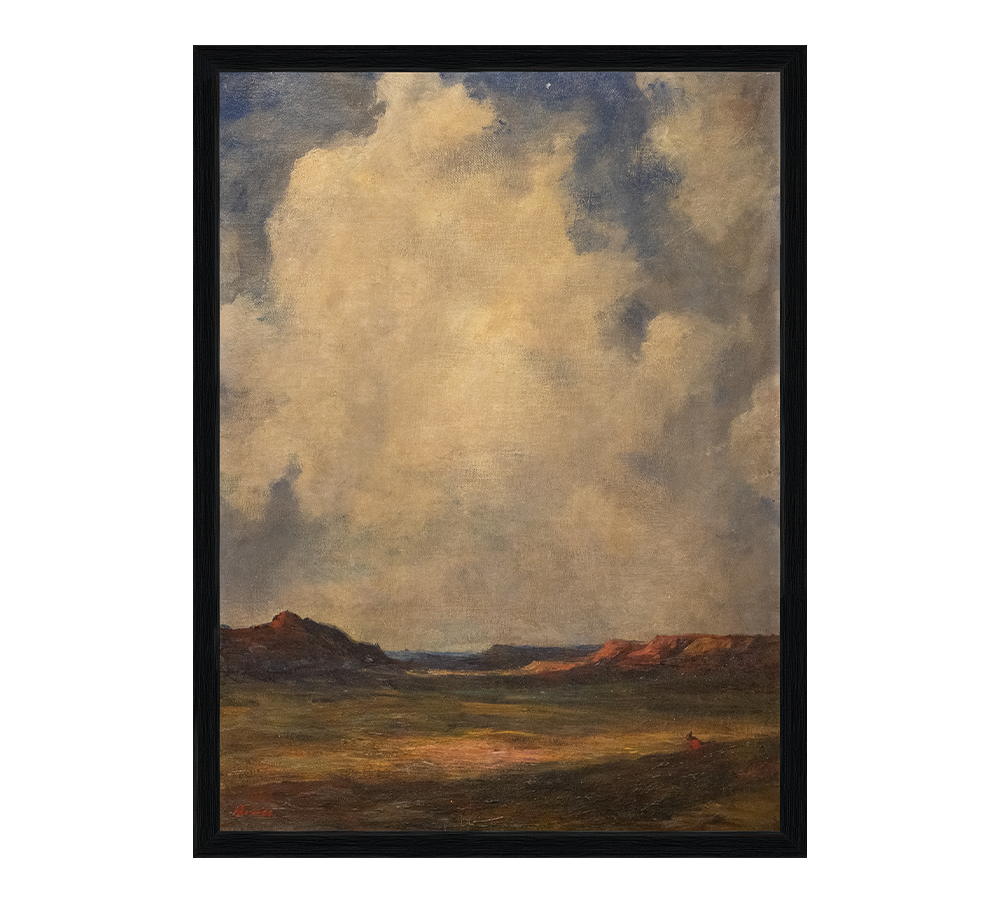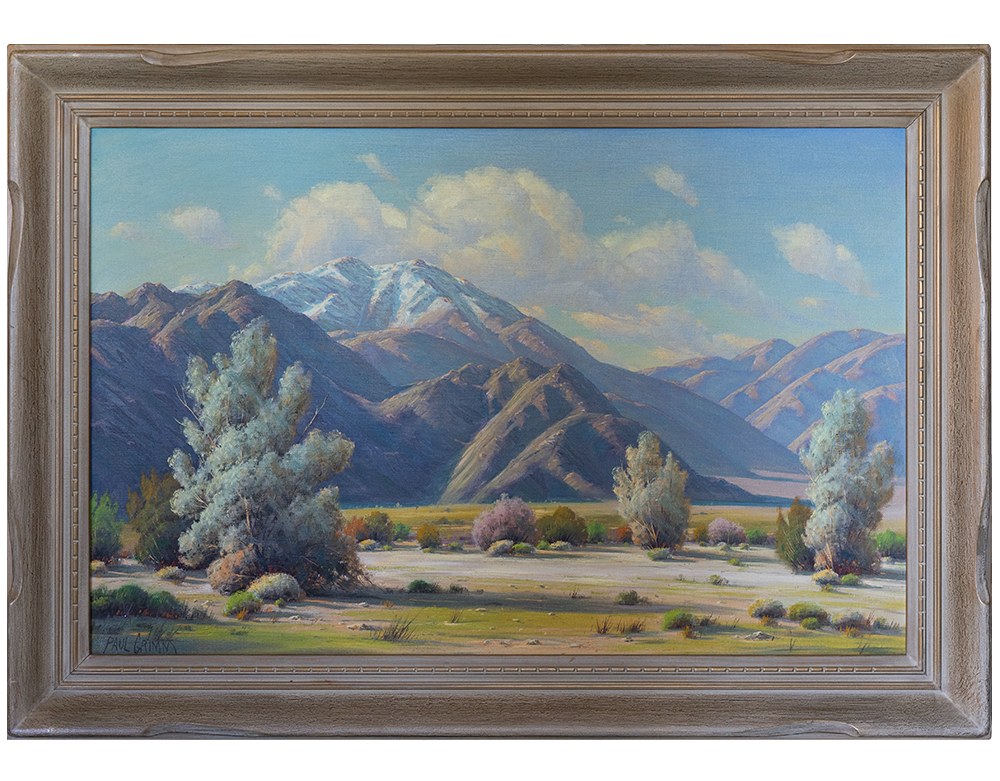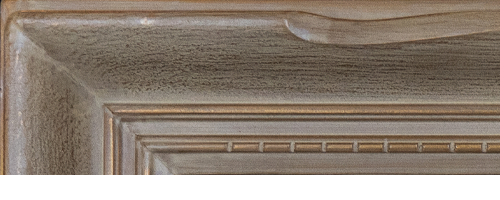Descriptions and notes by Fr. Nathan Zodrow, OSB, with the help of others.
Who was Edgar Samuel Paxson?

Edgar Samuel Paxson was born in East Hamburg, New York, near Buffalo, on April 25, 1852. After attending the Friends’ Institute school, Paxson entered his father’s business, painting carriages and signs, but there is no evidence that he received formal art training at this time. In 1875, Paxson set out for the western United States, where he worked for a stagecoach company as a guide and at other frontier jobs, providing experiences he would later use in his art. In 1878, he brought his family to Deer Lodge, Montana. In 1881, they moved to Butte, where he established a studio and produced easel paintings of historical subjects and portraits of Native Americans.
Paxson exhibited paintings at the Louisiana Purchase Exposition in St. Louis in 1904 and the Lewis and Clark Exposition in Portland, Oregon, in 1905, as well as other venues outside Montana. He moved to Missoula, Montana, in 1906. In 1911, he was commissioned to paint six scenes of Montana history for the Senate chambers at the Montana Capitol in Helena. The following year, he was commissioned to execute eight paintings for the Missoula County Courthouse. Edgar S. Paxson died November 9, 1919.
 Montana Forest Trail
Montana Forest Trail
Frame: 48″ x 64″ | oil on canvas | signed E. S. Paxson (1852 – 1915)
This 1914 wooded landscape by Edgar Samuel Paxson shows distant stair-step falls and a stream in the center. A small band of Native Americans ride horses along a path next to the stream. In 1878, Paxson brought his family to Deer Lodge, Montana, where he painted signs and scenery for theatrical backdrops. In 1881 they moved to Butte, where Paxson continued painting scenery, but also established a studio and produced easel paintings of historical subjects and portraits of Native Americans. In 1945, the painting was given to Mount Angel Abbey by Sarah Bernice Cox to sell to provide frames for the Price Memorial Collection. Luckily it was never sold.
 Frame: 3” bronze-gold rubbed frame with corner detail.
Frame: 3” bronze-gold rubbed frame with corner detail.
Who was William Samuel Parrott?

Born in Missouri in 1844, William Samuel Parrott arrived in Oregon with his family in 1847. He had a natural talent for drawing and, as a child, had a strong desire to reproduce scenes in color. At first, Parrott used wildflowers for paint pigment, cloth or bark for canvas, and strands of his sister Jane’s hair for brushes. He opened his first studio in the old National Bank Building in Portland in 1867. Parrott closed his Portland studio in 1887 to travel throughout Oregon, Washington, and California. His years of solitude in the mountains made him something of a recluse, often moody and temperamental. It was rumored that he would not sign any paintings he gave as gifts to ensure they would not achieve the commercial value of his signed works. According to family records, he eventually settled in Oakland, California, with his second wife, Sue Hendershott-Parrott, also a painter of some renown.
When Parrott’s health began to fail in 1911, he returned to the Northwest, where he spent the years until his death with his sister Jane in Goldendale, Washington. Another sister, Elizabeth Parrott Pond, was a well-known Washington state artist. Parrott’s mountain landscapes were very popular and were commissioned more than any subject. With his recognizable atmospheric effects, variations of “Sunrise Over Mt. Hood from Lost Lake” appear in many collections. One of his paintings of Mt. Hood was hung in the Louvre, while other mountain canvases can be found in museums and collections worldwide.
See Oregon painters: The First Hundred Years (1859 – 1959), Ginny Allen and Jody Klevit.
 Heaven and Hell
Heaven and Hell
Frame: 70.25″ x 58.25″ | oil on linen | signed Parrott (1845 – 1915)
This 19th-century romantic landscape by Oregon painter William Samuel Parrott portrays an eastward-looking view of Mt. Shasta and Mt. McLoughlin in California. In the foreground is a mythical landscape that includes exotic ruins and plants. The painting appears to be a meditation on the sublime nature of creation and the passing of human accomplishment. It is unknown how this painting came to be part of the Abbey Collection.
 Frame: Toned water gilt silver frame and liner with bronze powder painted stencil pattern.
Frame: Toned water gilt silver frame and liner with bronze powder painted stencil pattern.
Who was William Henry Price?

William Henry Price was born on February 14, 1864, in Irwin (near Pittsburg), Pennsylvania. He received only four months of formal art education when he was 15. Early on, he earned a degree in engineering and took responsibility for making a living to support his family until he was 52. Price eventually became superintendent of the Moonlight Mine of the Anaconda Copper Company in Butte, Montana.
In 1916, Price was diagnosed with a lung ailment and forced to quit mining work. Doctors gave him approximately six months to live “if he took care of himself.” He and his wife, artist and teacher Sarah Bernice Cox, then moved to California, hoping for his recovery in the fresh coastal air. Price did not die of his ailment, but could not return to his previous career. Instead, he resumed painting, creating many California seascapes and numerous land and mountain scenes.
Price was admitted to the Los Angeles Society of Painters and Sculptors in 1929. His work, “Incoming Tide,” won first prize by popular vote at the Pasadena Civic Art Exhibition. “High Sierras” won the James Ackley McBride prize for the best landscape at the annual exhibition of the Pasadena Society of Artists in 1936. The Pasadena Society of Artists admitted him to their circle and later unanimously voted him membership for life. He was one of the founders of the Academy of Western Painters as well as the Pacific Geographic Society, organized in 1929. He painted his last piece in 1937, called “The Fading Light.” The next day, he found that he had lost his eyesight. He died on September 12, 1940
 Laguna Coast / California
Laguna Coast / California
Frame: 28.5″ x 38.5″ | oil on canvas | signed by W. H. Price
This marine won high praise from art critics when shown in various California exhibitions in the 1930s. “Laguna Coast” was the choice of 2,000 persons who voted it first place at the Civic Art Exhibit at Pasadena, California, in 1937. It was given personally to Father Gabriel Morris, OSB, a monk of Mount Angel Abbey, in 1938 by William Price and Sarah Cox. After Price’s death in 1940, a memorial collection of Price oils was given to Mount Angel Abbey by Sarah Cox in memory of her late husband.

Frame: A solid gilded wood frame, apparently carved by Price himself and given to the Abbey with the painting. (Notes from Fr. Martin Pollard, OSB)
Who was Albert Lorey Groll?
Albert Lorey Groll (1866 – 1952) was born in New York, but as a young man travelled to Europe where he studied art in Munich and Great Britain. He returned to New York in 1895 and turned his attention from painting portraits to landscapes. In 1904, Groll traveled to the American Southwest and began painting landscapes in California, Arizona, and New Mexico. Groll commented that his move to the Southwest “has been my lucky stars.” He was elected into the National Academy of Design in 1910 and his work was included in the San Francisco Panama-Pacific Exhibition in 1915. Consistent with this period of naturalism, in Groll’s work nature is overwhelmingly powerful in proportion to human beings. In addition to his landscapes of the West, Groll was highly regarded for his work as an etcher.
 Arizona Rain Clouds
Arizona Rain Clouds
Image: 16″ x 12″ | oil on canvas board | signed Groll (1866 – 1952)
The immense sky of this painting portrays large rain clouds over the Arizona desert. The foreground is a simple desert landscape of orange, brown and smattering of light blues and green. The small red figure to the right may depict a Native American looking out over the valley, an example of how overwhelmingly powerful nature is in proportion to the human being in Groll’s work.
It is unknown how this painting came to be part of the Abbey Collection.
Who was Paul Grimm?
Paul Grimm (1891 – 1974) was born to German parents in South Africa. After moving to the United States as a child with his parents, his talent for art was encouraged and he studied university level art in New York as an adult. He settled in California as an adult where he gained much of his present-day fame for his oil-on-canvas paintings of landscapes of Southern California in the 1920s. Many works depict alluvial fans and desert vegetation in the eastern half of Riverside County.
 Neath San Jacinto
Neath San Jacinto
Frame: 33.75″ x 48″ | oil on canvas | signed Paul Grimm, (1891 – 11974)
This 1959 Southern California desert scene, Neath San Jacinto, was one of Paul Grimm’s favorite subjects. The Smoke Trees in the foreground to the magnificent San Jacinto are subtle but rich in various hues and texture. It is unknown how this painting came to be part of the Abbey Collection.
 Frame: Light colored wood with brushed finish.
Frame: Light colored wood with brushed finish.
 A Bit of Desert
A Bit of Desert
Frame: 27.5″ x 37.5″ | oil on canvas | signed Paul Grimm (1891 – 1974)
Southern California desert scene with two large palm trees in the center foreground marking a bend in the sandy road as it moves into the distance. Billowing clouds hang over the Sierra Nevada Mountains in the background. The colors are subtle but rich in their variety of hues and textures, making the piece inviting. It is unknown how this painting came to be part of the Abbey Collection.
 Frame: Light colored wood with brushed finish.
Frame: Light colored wood with brushed finish.
Who was Sarah Bernice Cox?
Sarah Bernice Cox was an artist and art instructor. After her husband, painter William Henry Price, died in 1940, Cox donated a sizable memorial collection of Price’s oils to the Abbey Art Collection. The collection also contains a number of pieces by Cox.
 Snoqualmie Falls
Snoqualmie Falls
Frame: 65″ x 42″ | oil on canvas | signed S. B. Cox
This 1897 painting depicts the 268-foot waterfalls east of Seattle, Washington, between Snoqualmie and Falls City on the Snoqualmie River. The view is directly toward the full vertical fall. In the foreground is the turbulent pool and flowing river. Steep tree-covered slopes descend to the river on each side. It was painted by Cox and given to Mount Angel Abbey in 1945, after the death of her husband.
 Frame: 3″ cove, American, bronze finish.
Frame: 3″ cove, American, bronze finish.
 Woodland Park, Seattle
Woodland Park, Seattle
Frame: 43.75″ x 59.5″ | oil on canvas | signed S. B. Cox
This 1897 oil painting depicts a brook stealing softly through a dense understory while shafts of sunlight highlight its course. The palette of rich, dense greens and other woodland tones shows the place of the future Seattle Woodland Park Zoo. Painted by Sarah Bernice Cox, the work was given to Mount Angel Abbey in 1945 after the death of her husband.
 Frame: 4″cove, fluted, rope with indent motifs, bronze paint finish.
Frame: 4″cove, fluted, rope with indent motifs, bronze paint finish.
Who was J. E. Stuart?
James Everett Stuart (1852-1941) was born in Maine but, with his family, moved to California while still a child. He studied under Virgil Williams and Raymond Dabb Yelland at the California School of Design in the late 1870s and was a prolific painter of the west coast, producing over 5,000 western landscape paintings in his career. As an adult, Stuart migrated to Portland, Oregon, where he was a leading member of the art scene for several years. A popular artist of the early 20th century, his works were known for their moody and dramatic style. Stuart’s name appears first in a list of the founding members of the Portland Art Club.

Mt. Adams
Frame: 37.75″ x 48″ | oil on canvas | signed J. E. Stuart 1882 (1852 – 1941)
This view of Mt. Adams, Oregon, shows the sun reflecting on the snow-covered slopes with storm clouds passing overhead. Below the overlapping dark hills of Mt. Adams, a small figure is seen walking along a path in the sunlit meadow. According to a notation on the back of the canvas, a sketch for this painting was made on July 9, 1881, and painted in 1882. The perspective is of Mt. Adams as seen from near Hood River, looking up White Salmon River. It is unknown how it came to be in the Abbey Collection.
 Frame: Ebonista-style gold; egg and dart motif.
Frame: Ebonista-style gold; egg and dart motif.
Who was Wm Steadman?
The American artist Joseph John Englehart signed his work using a variety of pseudonyms, including “Wm Steadman.” In 1902, Englehart opened a studio in Portland, Oregon, where he spent a large part of his time until 1904. In 1905 he participated in the Lewis and Clark Centennial exhibition. Englehart’s paintings had the goal of bringing the viewer closer to an actual experience of “being there” without the romantic overtone.
 Mt. Shasta from Castle Crags
Mt. Shasta from Castle Crags
Frame: 40″ x 70″ | oil on canvas | signed Wm Steadman, (1867 – 1915)
This oil on canvas, “Mt. Shasta from Castle Crags” (verso), depicts a river or stream flowing toward the viewer from a distant snow-covered Mt. Shasta. The water is lined with trees and a man walks on a path along the water on the right side. It is unknown how this painting came to be part of the Abbey Collection.
 Frame: Gold with a burnished finish.
Frame: Gold with a burnished finish.



 Montana Forest Trail
Montana Forest Trail Frame: 3” bronze-gold rubbed frame with corner detail.
Frame: 3” bronze-gold rubbed frame with corner detail.
 Heaven and Hell
Heaven and Hell Frame: Toned water gilt silver frame and liner with bronze powder painted stencil pattern.
Frame: Toned water gilt silver frame and liner with bronze powder painted stencil pattern.
 Laguna Coast / California
Laguna Coast / California
 Arizona Rain Clouds
Arizona Rain Clouds Neath San Jacinto
Neath San Jacinto Frame: Light colored wood with brushed finish.
Frame: Light colored wood with brushed finish. A Bit of Desert
A Bit of Desert Frame: Light colored wood with brushed finish.
Frame: Light colored wood with brushed finish. Snoqualmie Falls
Snoqualmie Falls Frame: 3″ cove, American, bronze finish.
Frame: 3″ cove, American, bronze finish. Woodland Park, Seattle
Woodland Park, Seattle Frame: 4″cove, fluted, rope with indent motifs, bronze paint finish.
Frame: 4″cove, fluted, rope with indent motifs, bronze paint finish.
 Frame: Ebonista-style gold; egg and dart motif.
Frame: Ebonista-style gold; egg and dart motif. Mt. Shasta from Castle Crags
Mt. Shasta from Castle Crags Frame:
Frame: